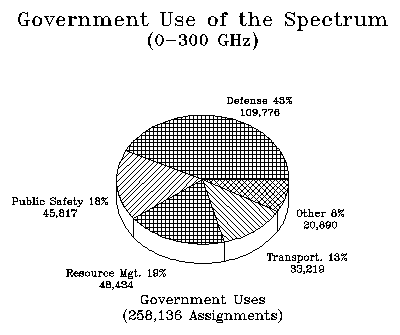The spectrum is used in a number of different ways. Perhaps the most common are the broadcasting and mobile communication services. These include, for broadcasting, AM and FM radio stations, UHF and VHF television stations, and potential new applications using satellites for direct broadcasting. Mobile communication services in the private sector include police and fire communications at the state and local levels, other state and local dispatch services, all forms of mobile communications systems used by business and industry and the general public, citizen's band radio, maritime radios aboard commercial and pleasure vessels, cellular radio, paging systems, trunked radio systems offered by the FCC's Specialized Mobile Radio Service, radios in commercial airplanes used for aeronautical radionavigation and communications, and the mobile satellite communications and tracking systems. In addition, a large amount of the spectrum is used for carrying voice, data, and video signals over long distances via microwave relay and satellite systems.
The pie chart below shows a number of the different ways that the Federal Government uses the spectrum to help in the accomplishment of its tasks. These uses include: Voice of America broadcasts, weather radio services, radars and voice communication systems used to control both commercial and pleasure aeronautical and maritime traffic, weather satellite systems, flood warning and water control systems, and time signals.

Almost every agency of the Federal Government uses the spectrum in performing mandated missions. The law enforcement agencies (the Justice, Treasury, and Interior Departments) use it for command and control of their forces, just as state and local police and fire departments do, with the exception that they must be able to operate throughout the United States. Park Service forest rangers use the spectrum every time they use their transportable radios for control of crowds or forest fires. The Energy Department uses it to transmit power control data and commands for their dams and power grids. The Federal Emergency Management Administration uses it for communications to disaster sites via emergency radio networks. The National Aeronautics and Space Administration uses it during satellite launches. NASA must communicate with satellites to collect data and command them. NASA must also use the spectrum to track launch vehicles and satellites and destroy them if necessary. The Department of Defense (DOD) uses the spectrum extensively for tactical uses and non-tactical uses. In the United States tactical uses are generally limited to a number of specific testing sites and training facilities, but DOD's non-tactical applications are extensive and include aircraft command and control, mobile communication in and around military bases and air fields and long distance communications using satellites.

|
To be contacted for a confidential consultation please E-mail: jmatk@tscm.com
or send a letter via US Mail to:
or call:
URL: http://www.tscm.com/ |